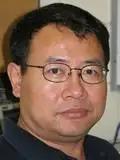De-Tong Jiang

Find Related People by Keyword
Education and Employment Background
Dr. De-Tong Jiang received his PhD in Condensed Matter Physics from Simon Fraser University in 1991. Between 1991 and 1994, he held a position as a Natural Sciences and Engineering Research Council of Canada (NSERC) Postdoctoral Fellow at Western University. He then worked as a Research Associate at Simon Fraser University, as a Beamline Scientist at Argonne National Lab in Chicago, and as an Adjunct Professor and Staff Scientist at the University of Saskatchewan. Jiang joined the Department of Physics at the University of Guelph in 2005 where he is now an Associate Professor.
Research Themes
Jiang’s research applies a multitude of synchrotron radiation-based techniques to probe the atomic/molecular structures for understanding the structure-function relationships and in some cases for acquiring the atomic/molecular level control of complex structures. Key areas of focus include:
- Growth and structural property studies of organic semiconductor films. Here, Jiang focuses on the polyacene semiconductor thin films. Three projects are underway: 1. In situ and ex situ carbon 1s polarization dependent NEXAFS studies on the tetracene and pentacene growth mechanisms on various solid substrates; 2. Gas phase NEXAFS of the polyaromatic molecules and theoretical simulation (StoBe code); 3. Ex situ grazing-incidence X-ray diffraction (GIXD) study on the thickness dependence of the expitaxial structures of tetracene on reduced silicon surfaces. The polyacene thin film NEXAFS and GIXD projects are in collaboration with Qin (U of G) group. Systems studied include tetracene and pentacene on H/Si(001) (wet chemistry method) and SiO2 substrates; and tetracene on flat and specific terraced H/Si(001) substrates. The polyacene gas phase project aims at developing a thorough understanding of the C 1s near edge X-ray absorption spectroscopy of these molecules for application as a structural tool in studying the polyacene semiconductor films.
- Structural properties of nickel silicide thin films. Jiang and his research group have been collaborating with Lavoie’s group (IBM, Yorktown Heights) to investigate the XANES and XAFS signatures of the industrial nickel silicide layers targeted for new generations of nanoscale electronic applications. Their method can identify the epitaxial phase of an interface region with thickness of 1-3 nm, where conventional diffraction methods have not been effective.
- Arsenic speciation in environmentally important systems. Arsenic speciation using XAFS endstation at CLS HXMA beamline has been carried out in collaboration with N. Chen (CLS), G. Demopoulos (McGill), and J. Rowson (AREVA Res., Canada), and S. Glasauer (Dept. of Land Resource Sci., U of Guelph). The researchers have systematically studied the pH, temperature, and aging time factors in the formation of scorodite phase under the geochemical conditions mimicking that at uranium mine tailing process facilities.
- Structural properties of materials under extreme conditions. The study of materials under extreme conditions involves diffraction and XAFS studies under high pressure environment generated with diamond anvil cells (DAC) (J. Tse/U of S, S. Desgreniers/U Ottawa, D. Klug/NRC, N. Chen and C.Y. Kim/CLS), aimed at the fundamental structural and electronic properties of materials under high pressure. A new research project is in progress which will invoke x-ray absorption spectroscopy studies on material electronic structures under high pressure.
Highlights
- NSERC Discovery Grant, 2009, 2014
- NSERC Collaborative Research and Development Grant, 2011-2013
- Brockhouse Beam Team, 2006-2017
- HXMA Beam Time Committee Member, Saskatchewan, 2000-2017